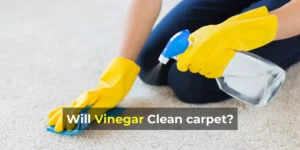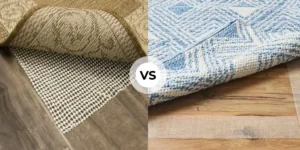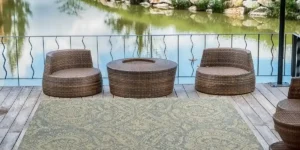Welcome to our comprehensive guide on installing artificial grass on concrete!
Are you tired of staring at that dull, gray slab outside your home?
Dreaming of a lush, green lawn but don’t have the space or desire to deal with natural grass maintenance?
Installing artificial grass on concrete is the perfect solution. Despite its various pros and cons, artificial grass is a great option for smaller concrete spaces.
In this comprehensive guide, we’ll take you through the simple steps required to install artificial grass on concrete, allowing you to enjoy the lush look and feel of a natural lawn without the hassle of maintenance.
| Difficulty: | Simple (2/5) |
| Time to Complete: | 6-7 hrs |
| Cost: | $250-$400 |
What you’ll need:
Before we get started let’s go over the materials you’ll need for this project.
Tools Needed:
- Mallet
- Knee Pads (Optional)
- Tape Measure
- Spade
- Wheel Barrow
- 1.5 m Spirit Level
- Utility knife
- Power brush
- Broom
- Mop
- Bucket
- Landscaping fabric
- Shovel
Supplies Needed:
- Wooden Stakes
- 100 mm x 25 mm Timber
- Artificial grass
- Artificial turf adhesive
- Sand (optional)
Steps to Install Artificial Grass on Concrete
Step 1: Prepare the Surface
Before diving into the installation, ensure the concrete surface is clean, smooth, and debris-free.
A smooth surface is essential for good bonding between turf and concrete. Before installing artificial grass, smooth out the surface with concrete filler or patches.
Step 2: Clean the Concrete Surface
Start by cleaning the concrete surface to remove dirt, debris, or stains. Use a broom to sweep away loose particles, and then wash the area with a mild detergent and water. Rinse and allow the surface to dry completely.
Step 3: Consider Drainage Flow
Make sure to consider drainage before installing artificial grass. Poor drainage can lead to water pooling on the concrete and cause the grass to deteriorate. A drainage system should be installed to manage water runoff properly.
Step 4: Measure and Plan

Roll out the artificial grass over the concrete to measure the area you want to cover. Then, use a utility knife to cut the artificial grass leaving a small overlap along the edges.
Take note of any obstacles such as drains, steps, or curbs that may need special attention during installation.
Step 5: Prepare the Surface
Apply a layer of adhesive primer to the clean concrete surface to improve adhesion between the concrete and the artificial grass. Allow the primer to dry completely.
Step 6: Apply Adhesive
Flip over the cut artificial grass, so the backing faces up.
Apply the adhesive or glue on the entire surface of the artificial grass backing using a trowel or adhesive gun. Be generous, but avoid excessive application.
If you’re installing multiple pieces of artificial grass. Use seam tape and adhesive to seamlessly join the edges.
Step 7: Trim Excess Edges

Once the grass is in place, use your utility knife to trim any excess edges.
Be precise to achieve a clean and polished look. A straightedge or wooden plank can be handy in guiding your cuts.
Secure the edges of the artificial grass with landscape spikes or adhesive to prevent shifting or lifting over time. Ensure that the edges are neatly tucked and secured for a professional finish.
Step 8: Brush and Fluff

After completing the installation, give your new artificial grass a good brush with a broom or leaf blower.
This helps the fibers stand upright and gives the grass a more natural appearance.
Step 9: Apply Sand (Optional)
The sand will help to absorb shock and improve drainage. Ensure that the sand is spread evenly over the entire area.
Pros and Cons of Installing Artificial Grass on Concrete
Pros
- Requires minimal upkeep compared to natural grass.
- Maintains a lush, vibrant appearance regardless of weather conditions.
- Withstands heavy foot traffic and is resistant to fading, staining, and pests.
- Helps save water resources by eliminating the need for irrigation.
- Offers design flexibility for various outdoor spaces.
Cons
- Higher upfront expense compared to natural grass.
- Absorbs and retains heat, potentially causing discomfort in warm weather.
- Inadequate drainage can lead to water pooling or runoff.
- May feel firmer underfoot compared to natural grass.
- Requires careful preparation and adherence to specific guidelines for a successful installation.
DIY vs. Hiring a Pro to Install Artificial Grass on Concrete
DIY:
- Cost-effective: Can save money on labor costs.
- Flexibility: Allows you to work at your own pace and schedule.
- Learning experience: Provides an opportunity to gain new skills and knowledge.
- Personalization: Enables you to customize the installation to suit your preferences.
Hiring a Pro:
- Expertise: Ensures professional and precise installation.
- Time-saving: Minimizes the time and effort required on your part.
- Quality assurance: Guarantees a high-quality and long-lasting result.
- Warranty protection: Offers warranty coverage for both materials and labor.
What Glue to Use for Artificial Grass on Concrete?
Artificial grass on concrete can be installed using several types of adhesives.
But, you have to look for a good-quality outdoor adhesive that is specifically designed for artificial grass. Or one that works well outdoors.
Make sure it’s suitable for both the concrete surface and the backing of the artificial grass.
This ensures a strong and lasting bond. You can find suitable adhesives at most home improvement or garden supply stores.
One adhesive brand commonly used for installing artificial grass on concrete is “ROBERTS 6700-1“.
Can I Just Lay Artificial Grass on Concrete?
Yes, it is possible, but there are a few things to keep in mind before taking the plunge.
- First, the concrete surface must be level, clean, and dry. Before installing artificial grass, repair any cracks, holes, or uneven surfaces.
- Secondly, a concrete primer or adhesive should be used to keep artificial grass in place.
- Thirdly, if you are installing artificial grass in areas with a lot of foot traffic or regular use.
Can I Lay Artificial Grass on Uneven Concrete?
No, it’s not recommended to lay artificial grass directly on uneven concrete.
Uneven surfaces can cause the artificial grass to wear unevenly and may result in an unsightly and unstable installation.
It’s best to level the concrete surface or consider alternative options such as using a base layer to create a smoother and more stable surface for the artificial grass.
Check Out More Articles Related to Flooring
- 7 Best Flooring Knee Pads for Floor Installers and Homeowners
- [Solved!] Why Does My Floor Shake When I Walk: 5 Common Causes
- Why Does Your Floor Make Your Feet Black? (7 Main Reasons)





